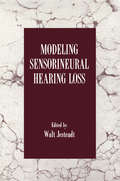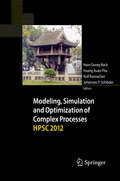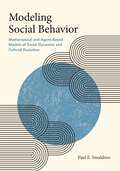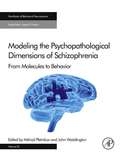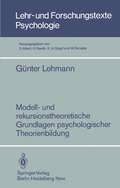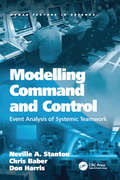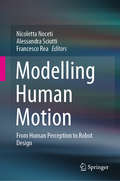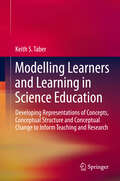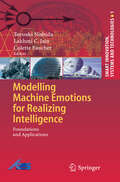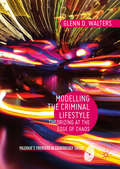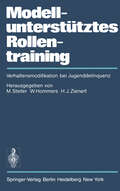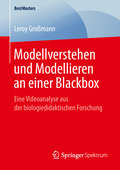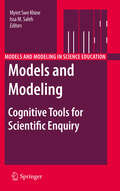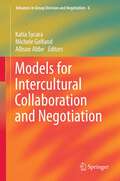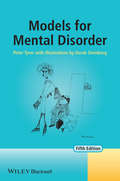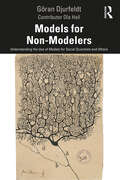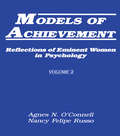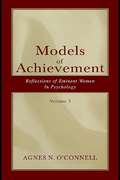- Table View
- List View
Modeling Sensorineural Hearing Loss
by Walt JesteadtA recent study indicates that 20 million people in the United States have significant sensorineural hearing loss. Approximately 95% of those people have partial losses, with varying degrees of residual hearing. These percentages are similar in other developed countries. What changes in the function of the cochlea or inner ear cause such losses? What does the world sound like to the 19 million people with residual hearing? How should we transform sounds to correct for the hearing loss and maximize restoration of normal hearing? Answers to such questions require detailed models of the way that sounds are processed by the nervous system, both for listeners with normal hearing and for those with sensorineural hearing loss. This book contains chapters describing the work of 25 different research groups. A great deal of research in recent years has been aimed at obtaining a better physiological description of the altered processes that cause sensorineural hearing loss and a better understanding of transformations that occur in the perception of those sounds that are sufficiently intense that they can still be heard. Efforts to understand these changes in function have lead to a better understanding of normal function as well. This research has been based on rigorous mathematical models, computer simulations of mechanical and physiological processes, and signal processing simulations of the altered perceptual experience of listeners with sensorineural hearing loss. This book provides examples of all these approaches to modeling sensorineural hearing loss and a summary of the latest research in the field.
Modeling Sensorineural Hearing Loss
by Walt JesteadtA recent study indicates that 20 million people in the United States have significant sensorineural hearing loss. Approximately 95% of those people have partial losses, with varying degrees of residual hearing. These percentages are similar in other developed countries. What changes in the function of the cochlea or inner ear cause such losses? What does the world sound like to the 19 million people with residual hearing? How should we transform sounds to correct for the hearing loss and maximize restoration of normal hearing? Answers to such questions require detailed models of the way that sounds are processed by the nervous system, both for listeners with normal hearing and for those with sensorineural hearing loss. This book contains chapters describing the work of 25 different research groups. A great deal of research in recent years has been aimed at obtaining a better physiological description of the altered processes that cause sensorineural hearing loss and a better understanding of transformations that occur in the perception of those sounds that are sufficiently intense that they can still be heard. Efforts to understand these changes in function have lead to a better understanding of normal function as well. This research has been based on rigorous mathematical models, computer simulations of mechanical and physiological processes, and signal processing simulations of the altered perceptual experience of listeners with sensorineural hearing loss. This book provides examples of all these approaches to modeling sensorineural hearing loss and a summary of the latest research in the field.
Modeling, Simulation and Optimization of Complex Processes - HPSC 2012: Proceedings of the Fifth International Conference on High Performance Scientific Computing, March 5-9, 2012, Hanoi, Vietnam
by Hans Georg Bock Xuan Phu Hoang Rolf Rannacher Johannes P. SchlöderThis proceedings volume gathers a selection of papers presented at the Fifth International Conference on High Performance Scientific Computing, which took place in Hanoi on March 5-9, 2012. The conference was organized by the Institute of Mathematics of the Vietnam Academy of Science and Technology (VAST), the Interdisciplinary Center for Scientific Computing (IWR) of Heidelberg University, Ho Chi Minh City University of Technology, and the Vietnam Institute for Advanced Study in Mathematics.The contributions cover the broad interdisciplinary spectrum of scientific computing and present recent advances in theory, development of methods, and practical applications. Subjects covered include mathematical modeling; numerical simulation; methods for optimization and control; parallel computing; software development; and applications of scientific computing in physics, mechanics and biomechanics, material science, hydrology, chemistry, biology, biotechnology, medicine, sports, psychology, transport, logistics, communication networks, scheduling, industry, business and finance.
Modeling Social Behavior: Mathematical and Agent-Based Models of Social Dynamics and Cultural Evolution
by Paul SmaldinoA comprehensive introduction to mathematical and agent-based modeling of social behaviorThis book provides a unified, theory-driven introduction to key mathematical and agent-based models of social dynamics and cultural evolution, teaching readers how to build their own models, analyze them, and integrate them with empirical research programs. It covers a variety of modeling topics, each exemplified by one or more archetypal models, and helps readers to develop strong theoretical foundations for understanding social behavior. Modeling Social Behavior equips social, behavioral, and cognitive scientists with an essential tool kit for thinking about and studying complex social systems using mathematical and computational models.Combines both mathematical and agent-based modeling of social behaviorIntegrates cognitive science, social science, and cultural evolutionCovers topics such as the philosophy of modeling, collective movement, segregation, contagion, polarization, the evolution of cooperation, the emergence of norms, networks, and the scientific processDiscusses more advanced topics, including how to use models to build a more robust empirical research programAn ideal introductory textbook for graduate students or advanced undergraduatesAn invaluable resource for practitioners
Modeling the Psychopathological Dimensions of Schizophrenia: From Molecules to Behavior (ISSN #Volume 23)
by Mikhail V. Pletnikov John L. WaddingtonModeling the Psychopathological Dimensions of Schizophrenia: From Molecules to Behavior is the first book to offer a comprehensive review of the new theoretical, clinical, and basic research framework that considers psychotic illness as a group of dimensional representations of psychopathology rather than as traditional distinct categorical diagnoses. Psychotic illness, typified by schizophrenia, is a devastating condition increasingly recognized as a disorder of abnormal brain development and dysconnectivity. Its complex etiology involves both genetic and environmental factors, as well as the interplay among them. This book describes the current understanding of the clinical and pathological features of schizophrenia, with a particular focus on the evolving conceptualization of schizophrenia and related diagnostic categories of psychotic illness as combinations of dimensional abnormalities. It provides an overview of modern strategies for generating cellular and whole animal models of schizophrenia as well as detailed reviews of the specific experimental preparations and paradigms aimed at molecular, developmental, and brain-network mechanisms that are the underlying aspects of abnormal behavior and various aspects of schizophrenia. This groundbreaking book is an authoritative overview of the translational impact of emerging clinical insights on basic research approaches in schizophrenia that will advance the reader’s understanding of the five major dimensions of psychopathology in schizophrenia and related psychoses and resolve the genetic and neurobiological underpinnings of these dimensions.Includes reviews of animal models that capture the most recent insights into the etiology and pathogenetic mechanisms of schizophrenia, with an emphasis on the translational potential of these modelsContains a series of reviews of recently available cellular models for analysis of signaling pathways and gene expression, which complement behavioral neuroscience research in schizophreniaEdited and authored by leading researchers in the field of schizophrenia and related psychoses
Modell- und rekursionstheoretische Grundlagen psychologischer Theorienbildung (Lehr- und Forschungstexte Psychologie #14)
by Günter LehmannModelle der Wissensrepräsentation als Grundlage qualitativer Wissensdiagnostik (Beiträge zur psychologischen Forschung #7)
by Sigmar-Olaf TerganModelling Command and Control: Event Analysis of Systemic Teamwork (Human Factors in Defence)
by Neville A. Stanton Chris BaberSince its inception, just after the Second World War, Human Factors research has paid special attention to the issues surrounding human control of systems. Command and control environments continue to represent a challenging domain for human factors research. Modelling Command and Control takes a broad view of command and control research, to include C2 (command and control), C3 (command, control and communication), and C4 (command, control, communication and computers) as well as human supervisory control paradigms. The book presents case studies in diverse military applications (for example, land, sea and air) of command and control. The book explores the differences and similarities in the land, sea and air domains; the theoretical and methodological developments, approaches to system and interface design, and the workload and situation awareness issues involved. It places the role of humans as central and distinct from other aspects of the system. Using extensive case study material, Modelling Command and Control demonstrates how the social and technical domains interact, and why each require equal treatment and importance in the future.
Modelling Command and Control: Event Analysis of Systemic Teamwork (Human Factors in Defence)
by Neville A. Stanton Chris BaberSince its inception, just after the Second World War, Human Factors research has paid special attention to the issues surrounding human control of systems. Command and control environments continue to represent a challenging domain for human factors research. Modelling Command and Control takes a broad view of command and control research, to include C2 (command and control), C3 (command, control and communication), and C4 (command, control, communication and computers) as well as human supervisory control paradigms. The book presents case studies in diverse military applications (for example, land, sea and air) of command and control. The book explores the differences and similarities in the land, sea and air domains; the theoretical and methodological developments, approaches to system and interface design, and the workload and situation awareness issues involved. It places the role of humans as central and distinct from other aspects of the system. Using extensive case study material, Modelling Command and Control demonstrates how the social and technical domains interact, and why each require equal treatment and importance in the future.
Modelling Human Motion: From Human Perception to Robot Design
by Nicoletta Noceti Alessandra Sciutti Francesco ReaThe new frontiers of robotics research foresee future scenarios where artificial agents will leave the laboratory to progressively take part in the activities of our daily life. This will require robots to have very sophisticated perceptual and action skills in many intelligence-demanding applications, with particular reference to the ability to seamlessly interact with humans. It will be crucial for the next generation of robots to understand their human partners and at the same time to be intuitively understood by them. In this context, a deep understanding of human motion is essential for robotics applications, where the ability to detect, represent and recognize human dynamics and the capability for generating appropriate movements in response sets the scene for higher-level tasks. This book provides a comprehensive overview of this challenging research field, closing the loop between perception and action, and between human-studies and robotics. The book is organized in three main parts. The first part focuses on human motion perception, with contributions analyzing the neural substrates of human action understanding, how perception is influenced by motor control, and how it develops over time and is exploited in social contexts. The second part considers motion perception from the computational perspective, providing perspectives on cutting-edge solutions available from the Computer Vision and Machine Learning research fields, addressing higher-level perceptual tasks. Finally, the third part takes into account the implications for robotics, with chapters on how motor control is achieved in the latest generation of artificial agents and how such technologies have been exploited to favor human-robot interaction. This book considers the complete human-robot cycle, from an examination of how humans perceive motion and act in the world, to models for motion perception and control in artificial agents. In this respect, the book will provide insights into the perception and action loop in humans and machines, joining together aspects that are often addressed in independent investigations. As a consequence, this book positions itself in a field at the intersection of such different disciplines as Robotics, Neuroscience, Cognitive Science, Psychology, Computer Vision, and Machine Learning. By bridging these different research domains, the book offers a common reference point for researchers interested in human motion for different applications and from different standpoints, spanning Neuroscience, Human Motor Control, Robotics, Human-Robot Interaction, Computer Vision and Machine Learning.Chapter 'The Importance of the Affective Component of Movement in Action Understanding' of this book is available open access under a CC BY 4.0 license at link.springer.com.
Modelling Learners and Learning in Science Education: Developing Representations of Concepts, Conceptual Structure and Conceptual Change to Inform Teaching and Research
by Keith S. TaberThis book sets out the necessary processes and challenges involved in modeling student thinking, understanding and learning. The chapters look at the centrality of models for knowledge claims in science education and explore the modeling of mental processes, knowledge, cognitive development and conceptual learning. The conclusion outlines significant implications for science teachers and those researching in this field.This highly useful work provides models of scientific thinking from different field and analyses the processes by which we can arrive at claims about the minds of others. The author highlights the logical impossibility of ever knowing for sure what someone else knows, understands or thinks, and makes the case that researchers in science education need to be much more explicit about the extent to which research onto learners’ ideas in science is necessarily a process of developing models.Through this book we learn that research reports should acknowledge the role of modeling and avoid making claims that are much less tentative than is justified as this can lead to misleading and sometimes contrary findings in the literature. In everyday life we commonly take it for granted that finding out what another knows or thinks is a relatively trivial or straightforward process. We come to take the ‘mental register’ (the way we talk about the ‘contents’ of minds) for granted and so teachers and researchers may readily underestimate the challenges involved in their work.
Modelling Machine Emotions for Realizing Intelligence: Foundations and Applications (Smart Innovation, Systems and Technologies #1)
by Toyoaki Nishida Colette FaucherEmotion connects the thought to the body, which is a magnificent biological - vice for sensing and affecting the world. The thought controls the body through emotions. The body affects the thought through emotions. Through this mec- nism, the thought allows the agent to behave intelligently in the complex world filled with a huge amount of dynamic information. The emotion maps a flux of information into a space which the agent is familiar with, enabling her/him to associate ongoing events with past experiences which help to reduce complexity by providing with a nominal solution. Recent findings in brain science suggest that mirror neurons map visual signals into motor signals for the body. This mechanism might permit one to experience the emotion of the other agent just by feeling the motor signals caused by mirror neurons as a result of visual stimuli caused by the other agent’s emotional beh- iors. In particular, it might play a significant role in invoking empathy in a social situation. It may not be hard to think about what might happen to emotion-less machines. The emotion-less machines may not be able to accumulate experiences to avoid serious failures. They may not be able to communicate with the humans in an empathetic way.
Modelling the Criminal Lifestyle : Theorizing at the Edge of Chaos
by Glenn D. WaltersThis book offers Walters's latest evolution of criminal lifestyle theory. It introduces the concept of criminal thought content to illustrate how the potential interplay between what offenders think and their thought processes can greatly aid our understanding of both crime and criminals. In this new study on criminal behaviour, Walters calls for criminological theory to be placed within a broader scientific context, and provides us with several key models which embrace constructs from numerous important theories including: the general theory of crime, social cognitive and social learning theories, general strain theory, psychopathic personality theories of crime, and labelling theory.Another unique aspect of this work is that it places lifestyle theory within a larger scientific framework, namely, nonlinear dynamical systems theory or chaos. Seven principles from chaos theory are used to explain relationships and processes central to lifestyle theory and Walters uses this to draw conclusions on what affects criminal decision-making and desistance from crime. Highly original and innovative in scope, this book will be useful to practitioners and scholars of criminal justice alike, with chapters focussed on decision-making, assessment, and intervention.
Modelling the Criminal Lifestyle : Theorizing at the Edge of Chaos
by Glenn D. WaltersThis book offers Walters's latest evolution of criminal lifestyle theory. It introduces the concept of criminal thought content to illustrate how the potential interplay between what offenders think and their thought processes can greatly aid our understanding of both crime and criminals. In this new study on criminal behaviour, Walters calls for criminological theory to be placed within a broader scientific context, and provides us with several key models which embrace constructs from numerous important theories including: the general theory of crime, social cognitive and social learning theories, general strain theory, psychopathic personality theories of crime, and labelling theory.Another unique aspect of this work is that it places lifestyle theory within a larger scientific framework, namely, nonlinear dynamical systems theory or chaos. Seven principles from chaos theory are used to explain relationships and processes central to lifestyle theory and Walters uses this to draw conclusions on what affects criminal decision-making and desistance from crime. Highly original and innovative in scope, this book will be useful to practitioners and scholars of criminal justice alike, with chapters focussed on decision-making, assessment, and intervention.
Modellunterstütztes Rollentraining (MURT): Verhaltensmodifikation bei Jugenddelinquenz
by J. C. Brengelmann M. Steller W. Hommers H. J. ZienertModellverstehen und Modellieren an einer Blackbox: Eine Videoanalyse aus der biologiedidaktischen Forschung (BestMasters)
by Leroy GroßmannLeroy Großmann entwickelt auf der Grundlage videografierter Blackbox-Untersuchungen eine Typologie von Modellierungsstrategien. Insbesondere in der biologiedidaktischen Forschung wurde eine Vielzahl quantitativer Untersuchungen zum Modellverstehen durchgeführt und damit das Kompetenzmodell der Modellkompetenz empirisch überprüft. Für das Modellieren als praktische Tätigkeit gibt es jedoch bislang kein ausdifferenziertes Kompetenzmodell – diese Forschungslücke wird mit der vorliegenden qualitativen Studie geschlossen. Die Relevanz der Befunde für den schulischen Biologieunterricht wird abschließend dargestellt.
Models and Modeling: Cognitive Tools for Scientific Enquiry (Models and Modeling in Science Education #6)
by Myint Swe Khine and Issa M. SalehThe process of developing models, known as modeling, allows scientists to visualize difficult concepts, explain complex phenomena and clarify intricate theories. In recent years, science educators have greatly increased their use of modeling in teaching, especially real-time dynamic modeling, which is central to a scientific investigation. Modeling in science teaching is being used in an array of fields, everything from primary sciences to tertiary chemistry to college physics, and it is sure to play an increasing role in the future of education. Models and Modeling: Cognitive Tools for Scientific Enquiry is a comprehensive introduction to the use of models and modeling in science education. It identifies and describes many different modeling tools and presents recent applications of modeling as a cognitive tool for scientific enquiry.
Models for Intercultural Collaboration and Negotiation (Advances in Group Decision and Negotiation #6)
by Katia Sycara, Michele Gelfand and Allison AbbeThis book is the first to bring together research material from different communities, Computer Science and especially Artificial Intelligence, and Social Sciences, e.g. Anthropology, Social Psychology, Political Science that present ideas and viewpoints, methods and models on inter-cultural collaboration and negotiation.With increasing globalization of business and science, cultural differences of the parties are an important factor that affects the process and outcomes of collaborative and self-interested interactions. The social science literature on culture as well as human collaboration and negotiation is vast. Most of this literature is devoted to work within the same culture. Artificial intelligence researchers, on the other hand, have developed computational models of cooperation, conflict resolution and negotiation, but paying almost no attention to identifying and modeling cultural factors. In recent years, we have witnessed a great increase in interest in understanding inter-cultural interactions. This has led to increased interest of social scientists and computational scientists in theoretical and experimental analysis of inter-cultural exchanges, modeling and support. Currently, these communities are largely unconnected. There is a great need to bring them together to share research work and experiences, discuss ideas and forge interdisciplinary collaborative relations. This book will be of interest to researchers from AI/computer science and social/behavioral sciences fields, such as psychology, sociology, communications, organizational science.
Models for Mental Disorder: Conceptual Models In Psychiatry
by Peter TyrerModels for Mental Disorder, first published in 1987, anticipated the move towards integration of psychiatric services into multidisciplinary teams (doctor, psychologist, nurse, social worker, etc) and the need to bring together the different philosophies of mental illness. Peter Tyrer has identified four different models of mental disorder that are relevant to clinical practice: the disease, psychodynamic, cognitive-behavioural and social models. Each model is described and reviewed, with reference to case studies and illustrations, to show how it relates to mental health disorders and can be used to interpret and manage these disorders. The book has been widely read and is often used for training purposes so that each professional can understand and appreciate that differences in viewpoint are often a consequence of one or more models being used in a different way rather than a fundamental schism in approach. Since the fourth edition was published in 2005, the disciplines of mental health have moved even closer together with the growth of assertive outreach and more integrated community teams. This, combined with the greater awareness of mental health among users of services, which leads to more penetrating and informed questions at interviews with professionals, has emphasized the need for a wider understanding of these models. • The only book to describe the models framing mental health diagnosis and management • A great review for those wanting a better grasp of psychiatric disorders and for integration of concepts for treatment planning • New information on formal classifi cations of mental disorder • New information on mindfulness and mentalization regarding the dynamic model • Clearly written in a style which includes some humour and a conversational presentation – a joy to read for the beginner and more experienced practitioner alike • Features a teaching exercise for use when training students in the various models
Models for Mental Disorder
by Peter TyrerModels for Mental Disorder, first published in 1987, anticipated the move towards integration of psychiatric services into multidisciplinary teams (doctor, psychologist, nurse, social worker, etc) and the need to bring together the different philosophies of mental illness. Peter Tyrer has identified four different models of mental disorder that are relevant to clinical practice: the disease, psychodynamic, cognitive-behavioural and social models. Each model is described and reviewed, with reference to case studies and illustrations, to show how it relates to mental health disorders and can be used to interpret and manage these disorders. The book has been widely read and is often used for training purposes so that each professional can understand and appreciate that differences in viewpoint are often a consequence of one or more models being used in a different way rather than a fundamental schism in approach. Since the fourth edition was published in 2005, the disciplines of mental health have moved even closer together with the growth of assertive outreach and more integrated community teams. This, combined with the greater awareness of mental health among users of services, which leads to more penetrating and informed questions at interviews with professionals, has emphasized the need for a wider understanding of these models. • The only book to describe the models framing mental health diagnosis and management • A great review for those wanting a better grasp of psychiatric disorders and for integration of concepts for treatment planning • New information on formal classifi cations of mental disorder • New information on mindfulness and mentalization regarding the dynamic model • Clearly written in a style which includes some humour and a conversational presentation – a joy to read for the beginner and more experienced practitioner alike • Features a teaching exercise for use when training students in the various models
Models for Non-Modelers: Understanding the Use of Models for Social Scientists and Others
by Göran DjurfeldtModels for Non-Modelers focuses not on how to design models but on how to understand and critically appraise them. Data and statistical models are widely used in disciplines such as epidemiology, climate science and systems design, but it can be difficult for those without the necessary training to understand and implement them. This book is for non-modelers, especially social scientists. Through extensive examination of some common models both in visual and text form, this book shows these non-modellers how to understand the problems, both in the logic and implementation of such models. It includes in-depth worked examples and boxed text for more technical aspects. It does not require the reader to have in-depth mathematical knowledge. Also working through some common models in epidemiology and climate change scholarship, it examines AI and the problem of causality. This book will be suitable for graduate students and researchers in the social sciences who would like to learn more about how to assess models and the steps they need to take to apply them in their own research, as well as for those taking first courses in quantitative methods and statistical analysis for research data analysis.
Models for Non-Modelers: Understanding the Use of Models for Social Scientists and Others
by Göran DjurfeldtModels for Non-Modelers focuses not on how to design models but on how to understand and critically appraise them. Data and statistical models are widely used in disciplines such as epidemiology, climate science and systems design, but it can be difficult for those without the necessary training to understand and implement them. This book is for non-modelers, especially social scientists. Through extensive examination of some common models both in visual and text form, this book shows these non-modellers how to understand the problems, both in the logic and implementation of such models. It includes in-depth worked examples and boxed text for more technical aspects. It does not require the reader to have in-depth mathematical knowledge. Also working through some common models in epidemiology and climate change scholarship, it examines AI and the problem of causality. This book will be suitable for graduate students and researchers in the social sciences who would like to learn more about how to assess models and the steps they need to take to apply them in their own research, as well as for those taking first courses in quantitative methods and statistical analysis for research data analysis.
Models of Achievement: Reflections of Eminent Women in Psychology, Volume 2
by Agnes N. O’Connell and Nancy Felipe RussoProviding role models of excellence for contemporary women and men and contributing to the understanding of the educational and career development of high achieving women, these autobiographical essays of seventeen women and their achievements generate a deeper appreciation of the vital role of women in the development of contemporary psychology.
Models of Achievement: Reflections of Eminent Women in Psychology, Volume 3
by Agnes N. O'ConnellThis outstanding book contains inspiring stories of late 20th century women who broke new ground in psychological knowledge and its applications. The lives and careers of 53 women are examined within social and historical contexts using three levels of analysis--the individual, the group, and the universal. The thoughtful autobiographies and the perceptive, integrative analyses increase understanding of the personal and professional development of these women, provide insights into their patterns of achievement, and illuminate new ways of thinking about and perceiving women. This extraordinary book is a valuable resource for libraries and researchers, provides knowledge and inspiration for a wide range of readers, and is an excellent supplementary text for courses in the psychology of women, history of psychology, lifespan development, career development, and women's studies.
Models of Achievement: Reflections of Eminent Women in Psychology, Volume 3
by Agnes N. O'ConnellThis outstanding book contains inspiring stories of late 20th century women who broke new ground in psychological knowledge and its applications. The lives and careers of 53 women are examined within social and historical contexts using three levels of analysis--the individual, the group, and the universal. The thoughtful autobiographies and the perceptive, integrative analyses increase understanding of the personal and professional development of these women, provide insights into their patterns of achievement, and illuminate new ways of thinking about and perceiving women. This extraordinary book is a valuable resource for libraries and researchers, provides knowledge and inspiration for a wide range of readers, and is an excellent supplementary text for courses in the psychology of women, history of psychology, lifespan development, career development, and women's studies.
